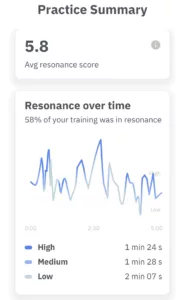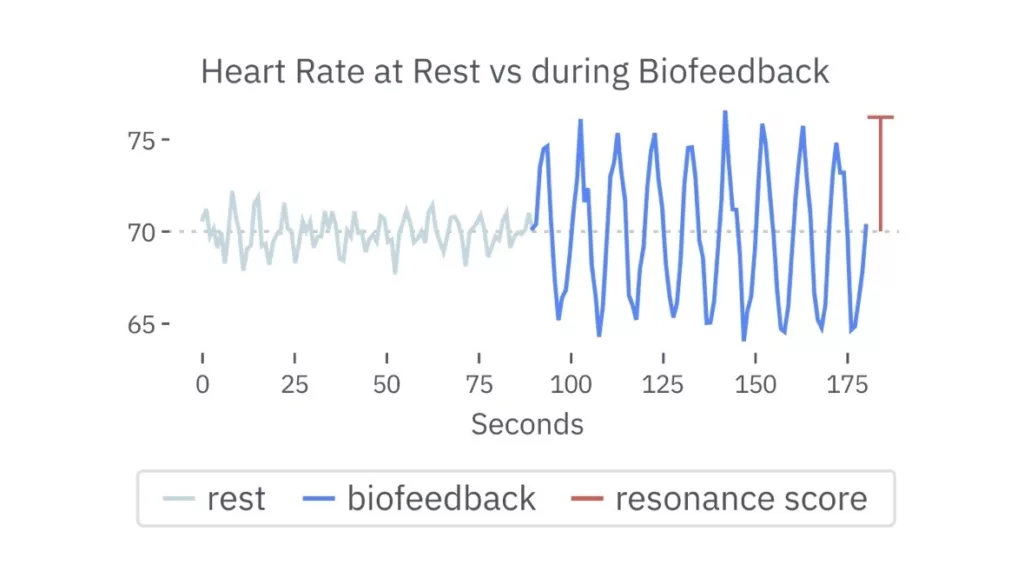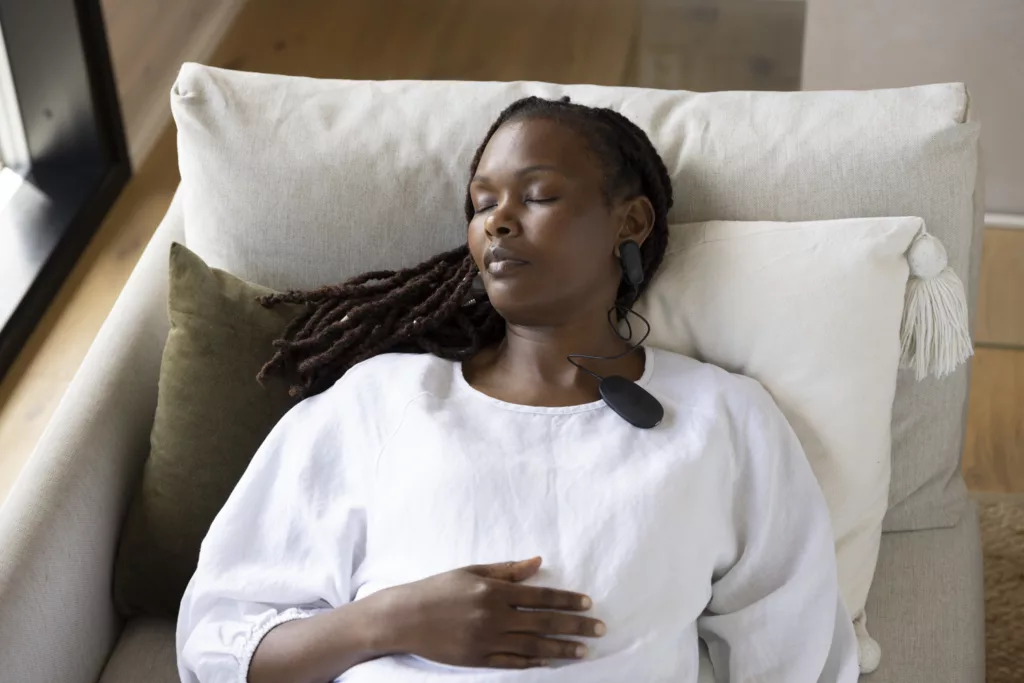Many of us have been under a great deal of stress these past few years, and it has taken a toll on our nervous systems. With a diet of constant catastrophe – from COVID and war to political turmoil, mass shootings, and climate crises – we are frankly just burned out. At Meru Health, we recognize that chronic stress takes a toll on both your mind and your body, and we are committed to a holistic approach to mental health. Meru Health is the only digital mental health program that helps sooth and strengthen your frazzled nervous system with biofeedback breathing practices.
We are excited to roll out our new “Meru Resonance Score” to help you understand how your heart is responding during biofeedback. We’ve listened to your user feedback, and we know you have a lot of burning questions about your biofeedback breathing metrics! Here’s what we’ll cover with more to come:
- What is my Resonance score?
- How do I interpret my Resonance score?
- How does getting in resonance help me feel better about life?
You may have noticed that this new summary screen appears after each biofeedback practice. It displays your overall Resonance score, with a graph of resonance over time. But, what exactly is your Resonance score?
Your heart rate naturally speeds up when you inhale and slows down when you exhale [1]. The goal of biofeedback breathing is to use your breath to maximize the variability in your heart rate. Think of this like a workout for your nervous system: over time, you become more stress-resilient and better able to choose how you respond.

A common misconception many people have about biofeedback breathing is that there’s only one metric. This is not true! There are many mathematical formulas and metrics for biofeedback breathing. But in general, higher heart rate variability (HRV) is better [2]. Lower HRV is associated with depression [3], and it also predicts increased risk for physical illness and even death [4].
If you have another wearable that gives you an HRV readout, it is probably a metric called “RMSSD”, or the root mean square of successive differences [2]. This metric works well for measuring HRV at rest. However, during biofeedback breathing, we need something different. We intentionally slow our breath down to generate very large, slow oscillations in HRV (see below). So, we capture this special pattern during biofeedback practices with a score called “Resonance.” Basically, your Resonance score is the amplitude of the heart rate waves created by slow-paced breathing.

Our biofeedback practices are different from other stress-reduction modalities. There are many apps with meditation and mindfulness content, and while they may feel good, they don’t change your HRV the same way. As we will see, this matters if you want to feel better!
Scientists have shown that, when you breathe at a pace close to 6 breaths per minute, you can maximize the variability in your heart rate [5,6]. In the figure below, you can see how much bigger HRV gets during biofeedback breathing than when you are resting and breathing normally. This rhythmic pattern sends signals to the brain via the nervous system, which helps strengthen emotion regulation [7,8].

At Meru, we provide you with a proprietary, scientifically-based score called your “Resonance Score” at the end of every session. That’s located at the top of your summary screen! (See below). Your summary screen will also show you a graph of your resonance over the course of the session, displaying the time you spent in low, medium or high resonance. This should match the feedback the pacer gave you by changing color from gray to light blue to deeper blue. Here, we will focus here on the top score – your overall resonance score – because that’s the best metric to use to compare yourself day to day and week to week.

To understand how your Resonance score compares to other participants like you, you could compare yourself to other people in your age range. This is important, because as we age, our heart and blood vessels age in ways that tend to make resonance scores go down.
Below in Table 1, you will find normative data based on thousands of Meru Health participants from different age groups. To interpret your score, look up your age category, and see what the average (or mean) resonance score is. Next, you will see a range that the majority of participants in this age category (or about 68%) fall into.
Table 1. Normed Resonance Scores by Age Category
Age Category | mean | typical range (+/- 1 std) |
|---|---|---|
18 – 24.9 years | 6.7 | (3.68, 9.72) |
25 – 29.9 years | 6.15 | (3.38, 8.92) |
30 – 34.9 years | 5.73 | (3.22, 8.24) |
35 – 39.9 years | 5.04 | (2.76, 7.32) |
40 – 44.9 years | 4.56 | (2.30, 6.82) |
45 – 49.9 years | 3.88 | (1.99, 5.77) |
50 – 54.9 years | 3.45 | (1.71, 5.19) |
55 – 59.9 years | 3.01 | (1.45, 4.57) |
60 – 64.9 years | 2.54 | (1.26, 3.82) |
65 – 80.0 years | 2.15 | (0.77, 3.53) |
If your score is lower than that bottom range, don’t worry! This measure is NOT intended to diagnose any illnesses – it’s just there to guide your progress. It’s very likely you just had an off day! Keep reading and we will give you some more tips on how to understand or work with low resonance!
The good news is that at every age, even if you have lower resonance, you can benefit from biofeedback practices! In older adults, biofeedback breathing has been shown to improve emotion regulation in just 5 weeks [7]. This study looked at neuroimaging data and measured how different regions of the brain talk to each other. These findings paint a picture of how biofeedback breathing may help you “rewire” your brain in ways that help improve your ability to stay resilient during stressful times. Not only that, biofeedback breathing also improves cognition [9] and may help patients with cardiovascular disease [10].
Lots of factors influence HRV, so we probably won’t be able to identify one specific reason. First let’s do a quick check-in on the basics, and then we will cover health habits and conditions that can affect HRV Resonance [5,11,12].
Do’s | Don’ts |
Do sit upright on a comfy pillow during HRVB. | Don’t lie down or recline back in a chair. |
Do clip the sensor to the fleshy part of the ear lobe, where an earring would go. | Don’t leave your earrings on when practicing. |
Do charge the sensor regularly. | Don’t leave the sensor connected to the cable when you aren’t using it or it will drain the battery. |
Next, try some little experiments with your health habits to learn about yourself. For example, people often don’t realize how much different stressful situations and health habits affect their bodies. Biofeedback breathing gives you the opportunity to learn: What affects your body the most?
- Poor sleep
- Dehydration
- A high-salt diet
- Caffeine
- Alcohol
- High stress
- Recovering from a recent cardio workout
- Getting sick or recovering from an illness
Last, here are several common health conditions that might be contributing to low resonance. Luckily, if you check one or more of these conditions, biofeedback breathing is even more likely to be beneficial for you [9,10]! Whereas therapy will focus on thoughts and behaviors, biofeedback breathing directly targets the nervous system. This is especially important for people who check one or more boxes below.
Health Conditions include:
- Feeling very depressed
- High blood pressure (hypertension)
- Cardiovascular disease
- Diabetes
Meru Health’s Resonance score is not intended for diagnosis. We use these scores to give us a general readout of how we are doing, and track trends over time. If you still have concerns that your Resonance score is low, please see your doctor!
Meru Health’s Resonance score is named after the underlying scientific theory of resonant breathing. The basic idea comes from applying the biophysics of oscillating systems that possess natural resonant frequencies to the human cardio-respiratory system [13]. In a nutshell, biofeedback breathing takes advantage of this biophysical phenomena to help you get the most benefit out of working out your nervous system in the shortest amount of time [14].
While meditation and mindfulness practices can sometimes lead to slower breathing and increased HRV, they do not optimize for high HRV as efficiently. Also, many people have a hard time sitting for long periods. If this sounds familiar, then the good news is that biofeedback breathing helps you maximize the return on your investment! Also, unlike meditation or mindfulness, with biofeedback breathing, you will have a score that help you know how you are doing [15].
Meru gives you a “Resonance” score after every biofeedback practice, and you can use that to compare how you are doing day to day. However, don’t expect that your resonance score or resting HRV will definitely increase over the course of the program. If you really want your HRV to improve, aim for 30 minutes of practice each week, and keep it up for 4-6 weeks. That’s really only 5 minutes a day! We can all find the time for that.
There are solid, peer-reviewed scientific studies in reputable journals that have shown that biofeedback breathing can improve symptoms of depression, cognition, cravings, and emotion regulation [9,12,14]. For example, in one recent review, leading scientists identified 58 high-quality studies of biofeedback breathing and pooled the results to understand whether biofeedback breathing worked across all the different laboratories, study populations, and differences in how biofeedback breathing was administered. Indeed, biofeedback breathing helped people reduce symptoms of depression and improve other aspects of wellbeing.
Neuroscientific research illustrates how biofeedback breathing improves the way we feel. Basically, biofeedback breathing helps you manage difficult emotions. One study compared participants randomized to biofeedback breathing with a “placebo” control condition in which participants also received real-time feedback on their heart rate and a “calmness” score. The control group’s breathing prescription did not produce large oscillations in HRV [7]. Hence, their resonance score would have been very low! After 5 weeks of practice, the group that achieved resonance showed significant improvements in the brain measures associated with better emotion regulation. This means that biofeedback breathing appears to have “rewired” the brains of these participants, so they were better able to manage stressful emotions. They became more resilient in the face of stress!
Scientists still do not know yet exactly what the best dose is for each individual [9,16]. But, Meru Health’s internal researchers are working hard to shed light on this important question! Of course, what the psychology of behavior change tells us is that the “best” amount of practice is the amount you will actually do on a regular basis! If that’s 5 minutes, then start by focusing on cultivating that daily habit. Most available research studies ask participants to practice for 5-6 weeks.
The best way to approach biofeedback breathing is just to do what you can, and try not to get too caught up in your Resonance score. The score is there to give you a way to compare your sessions from day to day and from week to week. But, like exercise, anything is better than nothing! Psychologists call this cultivating a “growth mindset.” You can’t force your nervous system to perform better right away. Ironically, feeling stressed and frustrated can actually decrease resonance. What you can control is your commitment to practicing regularly. So, don’t forget to thank yourself for practicing, no matter what your score!
References





